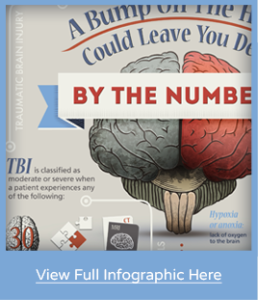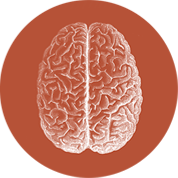
The suicides of famous NFL players such as Junior Seau and Dave Duerson after years of coping with concussion damage caused by ferocious hits on the football field generate most of the headlines concerning traumatic brain injuries.
But the fact is that all Americans, no matter their age, are susceptible to traumatic brain injuries, and such injuries are more common than you might suspect.
Traumatic brain injuries contribute to 30 percent of all injury deaths, according to the Centers for Disease Control and Prevention, and 138 Americans die each day from injuries that include TBIs.
Bumps, blows or jolts to the head as well as penetrating head injuries that disrupt normal brain functions cause traumatic brain injuries. Not all TBIs are deadly, and as the infographic shows, they are classified based on their severity.
Range of brain injury severity
Loss of consciousness lasting a few seconds or minutes or just the feeling of being dazed and confused. Tests or scans can appear normal. Changes in a person’s mental status occur only at the time of the injury. These often include concussions.
A person can lose consciousness for a few minutes to several hours, and confusion can follow for days or weeks. Impairment physically, cognitively and behaviorally can last months or permanently. Proper treatment can lead to recovery, and in some instance people can find ways to compensate for problems.
Usually caused by an open head injury that crushes or seriously fractures the skull. Often requires extended hospital stays and intensive rehabilitation. Most of the time, the victim will not return to normal. Severe brain injuries can be caused by closed injuries as well.
Survivors of traumatic brain injuries may feel the effects of the injury for a few days or have to cope with lasting effects.
Traumatic brain injuries can impair a person’s thinking or memory, ability to move or senses such as vision and hearing. Brain injuries also can cause changes in personality and depression, which may
dramatically affect families.
How prevalent are traumatic brain injuries?
- Some 2.5 million emergency room visits, hospitalizations or deaths in 2010 were linked to TBIs across the nation. TBIs contributed to 50,000 deaths and were diagnosed in 280,000 hospitalizations and 2.2 million trips to the emergency room.
- In the decade from 2001 to 2010, emergency room visits for TBI-related injuries jumped 70 percent while hospitalization rates went up only 11 percent.
- Emergency room physicians diagnosed nearly a quarter-million children 19 and younger in 2009 with concussions or TBIs related to sports and recreation injuries. From 2001 to 2009, the rate for those injuries increased 57 percent.
Symptoms of brain injuries
Physical: Includes headaches, sleep changes, dizziness, problems with balance, fatigue, sexual dysfunction, seizures, sensory changes and loss of strength
 Cognitive: Confusion and agitation, trouble with attention, loss of memory, decision-making problems, speech difficulty, slowed thought process
Cognitive: Confusion and agitation, trouble with attention, loss of memory, decision-making problems, speech difficulty, slowed thought process
Emotional: Depression, anxiety, irritability, impulsiveness, mood swings, bad behavior, out-of-character actions
Main causes of traumatic brain injuries
- Falls are a primary cause of TBIs. Children and senior citizens are the most likely groups to suffer fall-related traumatic brain injuries. Falls caused 55 percent of TBIs in children up to 14 years old and 81 percent of TBIs among adults 65 and older.
- Unintentional blunt trauma such as being struck in the head with an object is the second main cause of brain injuries.
- Nearly one-fourth of TBIs in children under 15 are linked to blunt trauma.
- Car accidents and traffic accidents account for 31.8 percent of deaths involving traumatic brain injuries.
- Assaults are the fourth leading cause of TBIs, making up 10 percent of every case, with some 75 percent of assault-related TBIs occurring in those ages 15 to 44. Assaults account for 3 percent of TBIs in children 14 and under and 1.4 percent of the cases in adults 65 and older.
Main risk factors for traumatic brain injuries, 2006-2010
- Men were nearly three times more likely to die than women.
- Senior citizens 65 and older suffered the highest rates.
- Falls were the main cause of TBI-related deaths for seniors.
- For those 5 to 24, motor vehicle crashes were the primary cause of TBI-linked fatalities.
- Men were more likely to be hospitalized with brain injuries or go to the emergency room than women.
- Senior citizens were most likely to be hospitalized.
- Emergency room visits were highest for children 4 and under.
Exclusive post provided by Leavitt, Yamane, & Soldner
